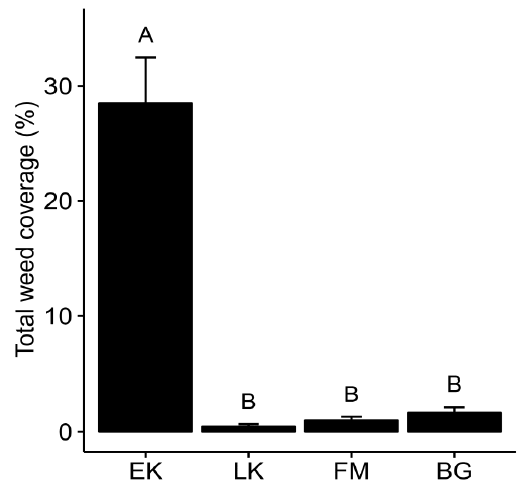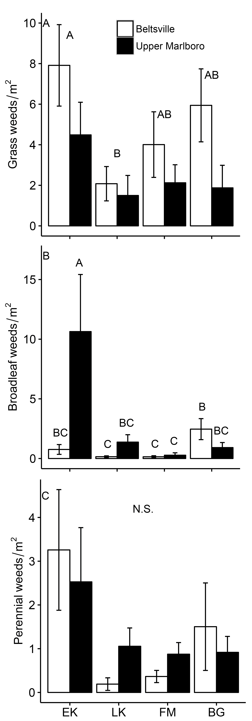Alan Leslie*, Armando Rosario-Lebron, Veronica L. Yurchak, Guihua Chen & Cerruti Hooks
University of Maryland, Department of Entomology
*University of Maryland Extension, Charles County
Farmers’ decisions about when and how to terminate their cover crops can enhance, decrease, or have no effect on weed establishment in the following crop. Winter cover crops are typically terminated with a burn-down herbicide during early to late spring, which also kills any germinated weeds before planting the cash crop. A residual herbicide is often included as a tank-mix to provide some protection from future weed germination. This practice provides weed suppression through cover cropping and herbicide usage. However, timing of cover crop termination can affect weed populations by influencing cover crop biomass and the amount of residue that remains on the soil surface.
Delaying cover crop termination has the potential to improve weed suppression through greater cover crop biomass accumulation. However, this delay can negatively affect the subsequent cash crop if the growing cover crops deplete soil moisture with increased evapotranspiration. As such, effects of cover crop termination date on weed management must take into account its impact on soil water availability. The Maryland Department of Agriculture’s cover crop program includes a new incentive for the 2019/2020 cover crop season called the Extended Season option. This new incentive encourages late termination by paying farmers an additional $15 per acre when they agree to terminate their cover crops after May 1. However, concerns about soil moisture and yield of the following soybean crop may keep some farmers from participating in this program.
Field experiments were conducted at two sites in Maryland in 2013 and 2014 to examine how varying the termination date and method of barley cover crop affects the weed community, soil moisture and yield in the following no-till soybean crop. This experiment compared four treatments: (1) early-kill with burn-down and residual herbicides (EK), (2) late- kill with burn-down and residual herbicides (LK), (3) late-kill with a flail mower and residual herbicides (FM), (4) and a fallow/bare-ground check with burn-down and residual herbicides (BG). Terminating the barley late or just prior to soybean planting resulted in significantly greater barley biomass accumulation in LK and FM than EK (Table 1).
Table 1. Mean cover crop or winter weed biomass at time of herbicide burn-down or flail mowing.

Weed density, soil coverage and species diversity were measured to determine effects of cover crop management tactics on weed suppression. Weed growth measurements were conducted after soybeans reached the early vegetative growth stage and continued until soybean canopy closure. Soil moisture was measured throughout the season at Beltsville using electrical resistance sensors to determine the effect of cover crop management on soil moisture dynamics. Soybeans were harvested using small plot combines. Weed composition, in terms of species and their relative abundances, was similar between study sites. There were 16 weed species identified at each site; the most abundant grass weeds at both sites were large crabgrass (Digitaria sanguinalis) and goosegrass (Eleusine indica). The most abundant broadleaf weed at Beltsville was white clover (Trifolium repens), while white clover was second in abundance to carpetweed (Mollugo verticillata) in Upper Marlboro. The EK treatment had the greatest weed coverage (Fig. 1). In Upper Marlboro, total weed coverage was greater in EK than FM or LK treatments and more grass weeds were found in EK than LK plots (Fig. 2a). In Beltsville, BG had significantly more annual broadleaf weeds than FM or LK treatments (Fig. 2b). However, the number of perennial weeds was similar among treatments (Fig. 2c).

Soil moisture levels fluctuated with rainfall events throughout the growing season, and appeared to show a response to increased water demand of soybean plants following canopy closure both years. There was no significant effect of treatment either before or after canopy closure on soil moisture either year. Similarly, soybean yields were similar among all treatments.

In summary, the EK treatment had the lowest cover crop biomass and the highest weed pressure among treatments. However, increased biomass in LK and FM did not result in better weed suppression than the BG treatment, and there were no differences in weed pressure between LK and FM. Method and timing of termination had no significant effect on soil moisture or yield. Results from this experiment suggest that mechanically terminating a cover crop can be as effective as using a burn-down herbicide for managing weeds in a subsequent soybean crop if a residual herbicide is used, and that delaying cover crop termination or herbicide application until just prior to soybean planting can result in reduced weed pressure during the season.
Soybean farmers in Maryland generally kill their cover crop early partially out of concern that cover crops will dry out soils ahead of planting the next crop. During this experiment, there was no evidence of lower soil moisture or suppressive effects on soybean emergence, growth, or yield in cover crop treatments terminated late. From the perspective of weed management, these results encourage cover crop management strategies that delay termination until just prior to planting the soybean crop. As such, results from this study show that timing of cover crop termination is important for managing weeds and that in some instances mechanical termination of cover crops may substitute chemical termination without a loss in weed suppression benefits. Although this may not be true under all growing conditions, the best practice for weed management among methods tested during this study is using a combination of narrow row spacing and terminating the cover crop as late as possible, as this provides the best opportunity for preventing the need for further herbicide applications later in the season. Results of this study show that farmers can opt-in to the Maryland Department of Agriculture’s new Extended Season incentive without expecting negative impacts on soybean growth or yield.
For more details: view the full-text article in the Crop Protection Journal (https://doi.org/10.1016/j.cropro.2018.10.020).
Acknowledgements
We thank crews at the Upper Marlboro and Beltsville Research and Education Centers for logistics in establishing field trials. This work was supported by Hatch Project No. MD-ENTO-9107/project accession no. 227029 from the USDA National Institute of Food and Agriculture, Maryland Soybean Board and USDA NIFA EIPM number 2017-70006-27171.
 The annual sign-up period for the Maryland Department of Agriculture’s cover crop program will take place June 21 – July 17 at soil conservation district offices statewide. This popular grant program provides farmers with cost-share assistance to offset seed, labor, and equipment costs associated with planting fall cover crops.
The annual sign-up period for the Maryland Department of Agriculture’s cover crop program will take place June 21 – July 17 at soil conservation district offices statewide. This popular grant program provides farmers with cost-share assistance to offset seed, labor, and equipment costs associated with planting fall cover crops.






